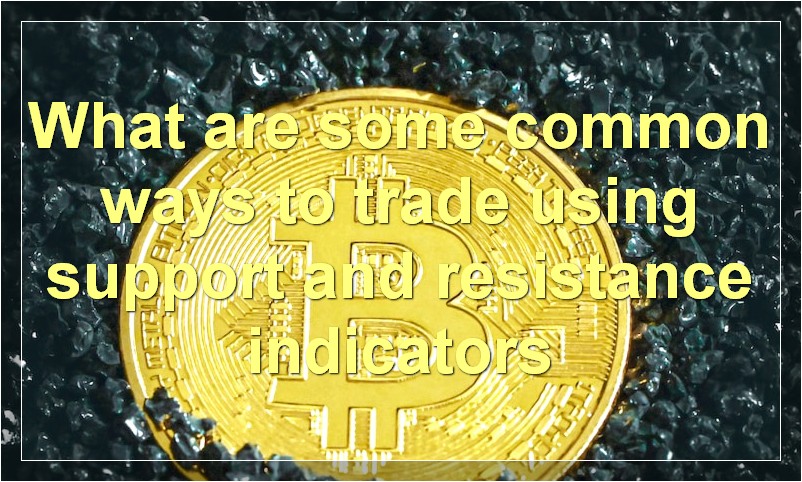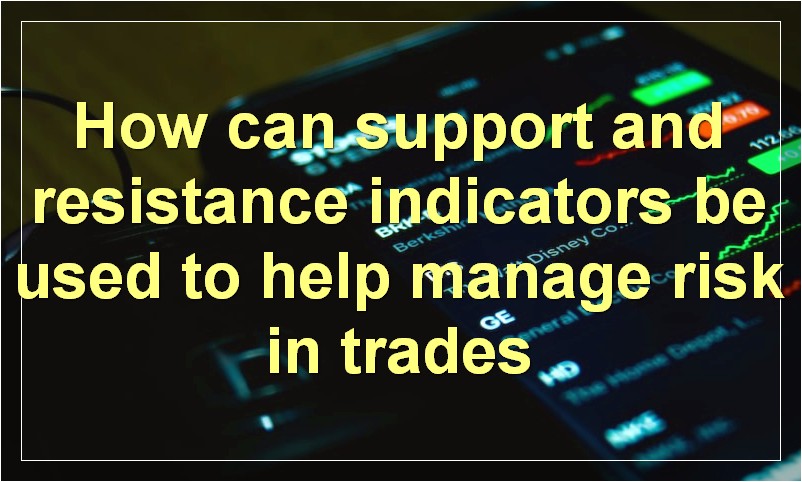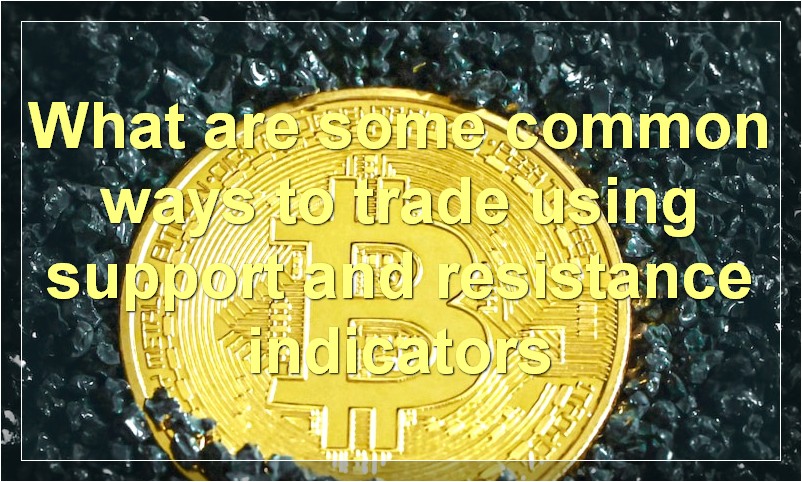The most popular support and resistance indicator is the moving average.
What is the most popular support and resistance indicator
The support and resistance indicator is one of the most popular technical indicators used by traders. It is a simple yet powerful tool that can help you identify key levels in the market where price is likely to reverse.
There are many different ways to calculate support and resistance, but one of the most common methods is to use moving averages. Simply put, this indicator plots the average price of a security over a given period of time. When the price is above the moving average, it is considered to be in an uptrend. Conversely, when the price is below the moving average, it is considered to be in a downtrend.
One of the main advantages of using a moving average as a support and resistance indicator is that it is dynamic. This means that it will adjust as the market conditions change. This is in contrast to static indicators like Fibonacci levels which remain constant regardless of market conditions.
Another advantage of using moving averages as a support and resistance indicator is that they are easy to interpret. Even novice traders can quickly identify when price is approaching a key level.
If you are looking for a simple yet effective support and resistance indicator, then a moving average is definitely worth considering.
What are some common ways to trade using support and resistance indicators

If you are looking to trade using support and resistance indicators, there are a few common ways to do so. One way is to look for price action at key levels of support and resistance. Another way is to use technical indicators such as the moving average convergence divergence (MACD) or the relative strength index (RSI). Finally, you can also use Fibonacci levels to identify potential areas of support and resistance.
How can support and resistance indicators be used to identify potential reversals in the market
When trading in the financial markets, it is important to be able to identify potential reversals in the market. This can be done by using support and resistance indicators.
Support and resistance indicators are technical indicators that are used to identify areas where the price of a security is likely to reverse. They are based on the principle of supply and demand.
Supply and demand is the basic principle of Economics that drives the prices of goods and services in the market. When there is more demand for a product than there is available supply, the price of the product will increase.
Conversely, when there is more supply than there is demand, the price of the product will decrease. In the financial markets, this principle is applied to the price of securities.
Support and resistance indicators are based on this principle and are used to identify areas where the price is likely to reverse. There are many different types of support and resistance indicators, but they all work on the same basic principle.
The most common type of support and resistance indicator is the moving average. Moving averages are calculated by taking the average price of a security over a certain period of time.
For example, a 50-day moving average would be calculated by taking the average price of a security over the past 50 days. Moving averages can be used to identify both support and resistance levels.
If the price of a security is above its moving average, it is said to be in an uptrend. If the price is below its moving average, it is said to be in a downtrend.
Moving averages can also be used to identify reversals in the market. If the price of a security breaks below its moving average, it is often an indication that the uptrend has reversed and that the price may continue to fall.
Similarly, if the price breaks above its moving average, it may be an indication that the downtrend has reversed and that the price may start to rise again. There are many other types of support and resistance indicators, but moving averages are one of the most commonly used.
What are some key considerations when trading with support and resistance indicators
When trading with support and resistance indicators, there are a few key things to keep in mind. First, it is important to identify the level of support or resistance. This can be done by looking at past price action and identifying where the prices have consistently found support or resistance. Once the level is identified, it is important to wait for a price action signal to confirm that the level is still valid. This could be a candlestick pattern or another type of technical indicator. Finally, once a trade is entered, it is important to place a stop loss just below the level of support or above the level of resistance. This will help to protect against a sudden move in the opposite direction.
What are some of the benefits of using support and resistance indicators
Some of the benefits of using support and resistance indicators are that they can help you to:
-identify key levels at which the market is likely to turn
-enter and exit trades with greater precision
-set stop-losses and take-profits more effectively
-manage your risk exposure more efficiently
Overall, using support and resistance indicators can help you to become a more successful trader by improving your ability to identify market reversals and make more informed trading decisions.
How can support and resistance indicators be used to help manage risk in trades

When trading in the financial markets, it is important to manage risk effectively in order to maximise profits and minimise losses. One way of doing this is by using support and resistance indicators.
Support and resistance indicators can be used to identify key levels at which the price of an asset is likely to find support or resistance. This information can then be used to help manage risk in trades, by setting appropriate stop-losses and take-profit levels.
For example, if a trader is long on an asset that is approaching a key resistance level, they may choose to set a stop-loss just below this level. Conversely, if a trader is short on an asset that is approaching a key support level, they may choose to set a take-profit just above this level.
By using support and resistance indicators to help manage risk in trades, traders can increase their chances of success and minimise their potential losses.
What is the difference between horizontal and dynamic support and resistance
Horizontal support and resistance are used to identify potential price reversal levels on a chart. Dynamic support and resistance are based on moving averages and market momentum.
What are some of the drawbacks of using support and resistance indicators
One of the main drawbacks of using support and resistance indicators is that they can often give false signals. This can lead to investors making trades that they would not have otherwise made, and can ultimately lead to losses. Another drawback is that these indicators can be lagging, meaning that they may not give signals until after a move has already begun. This can make it difficult to get into a trade at the optimal time. Finally, support and resistance indicators can be subject to interpretation, so two investors may look at the same chart and come to different conclusions about where the levels are.
How can traders use multiple support and resistance indicators to make trading decisions
If you’re a trader, then you know that one of the most important things to consider when making trading decisions is support and resistance. But what happens when you have multiple support and resistance indicators? How can you use them to your advantage?
Here’s a quick rundown:
The first thing you need to do is identify the different types of support and resistance indicators. Some of the most popular ones include moving averages, Fibonacci levels, and trendlines.
Once you’ve identified the different types of indicators, you need to look at how they interact with each other. For example, if you have two moving averages that are both pointing in the same direction, then that’s a strong signal that the market is trending in that direction.
You can also use multiple indicators to confirm each other. For example, if you have a Fibonacci level that lines up with a moving average, then that’s a strong sign that the market is indeed at a support or resistance level.
Lastly, don’t forget to pay attention to price action. This is one of the most important things to look at when making any kind of trading decision. Price action will give you clues as to whether or not the support or resistance is holding.
So there you have it! A quick guide on how to use multiple support and resistance indicators to your advantage. Just remember to always do your own research and never trade on pure indicator signals alone.
What are some tips for using support and resistance indicators effectively
There are a few things to keep in mind when using support and resistance indicators:
1. First, it is important to identify the key levels of support and resistance. These levels are typically determined by looking at previous market highs and lows.
2. Once the key levels are identified, it is important to watch for price action around these levels. If the price is bouncing off of a support level, it may be an indication that it is a strong level and that the market is bullish. Similarly, if the price is rejected at a resistance level, it may be an indication that it is a strong level and that the market is bearish.
3. Finally, it is important to remember that support and resistance levels are not exact numbers, but rather areas where the price is likely to find support or resistance. As such, it is important to use other technical indicators in conjunction with support and resistance levels to confirm trading signals.

